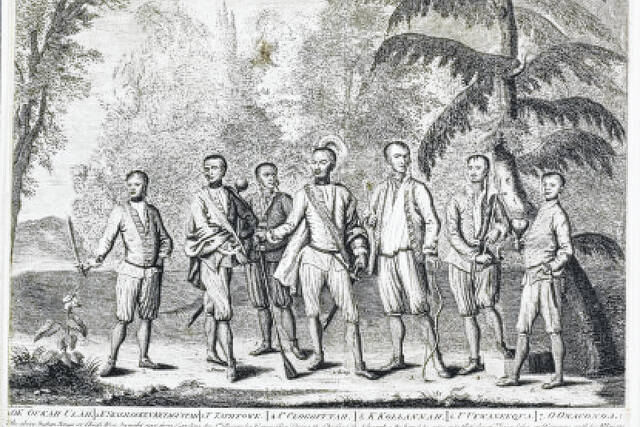
Scotsman Sir Alexander Cuming met with Cherokee leaders at the council house at Nikwasi to form a peaceful agreement.
Courtesy NCDNCR
THIS WEEK IN HISTORY
ROBESON COUNTY HISTORY
March 31: First Indian commencement. First Indian county commencement at Pembroke so big it is a day to reckon from. The March 31, 1924, Robesonian reported that “Large crowds attend big educational meeting in Pembroke…. A parade nearly a mile long in which approximately 1,400 school children took part, speeches by Prof. N.C. Newbold, state superintendent of Indian teachers training, and State Senator L.R. Varser, an attendance of nearly 3,500 and various contest featured the Indian county commencement held at Pembroke Friday, the first ever held in Robeson County.
March 31: Six arrested on drug raps. The March 31, 1974 Robesonian reported the arrest of six people, “all involving possession of marijuana… in the past three days according to reports by the Robeson County Sheriff’s Department.”
March 30: Area market hog producers earn $13,754.30 in annual show. Supporters of Robeson County swine producers, paid $13,754.30 last night to purchase 24,558 pounds of livestock at the 11th Robeson County Market Hog Show. Receipts for sale topped last year’s sale of $10,300 by nearly $3,500. Prices paid for show livestock totaled $5465.98 above what the same hogs would have brought at yesterday’s support price of 33.75 cents. March 27: Robeson Schools tops in spanking. The March 27, 2016 Robesonian reported that “Robeson County once again is ranked first for use of corporal punishment in public schools out of the four counties in North Carolina where paddling is still permitted. A recent report by the Department of Public Instruction found that 88 of the 147 children who were physically punished in the North Carolina school system during the 2014-2015 school year were students in the Public Schools of Robeson County. Eighty of those 88 in Robeson County were American Indian, according to the report.
NORTH CAROLINA HISTORY
April 1: Tar Heels Say No to the Mobro Garbage Barge. State and federal environmental officials examine the garbage aboard the Mobro 4000. Image from Vice.
On April 1, 1987, WRAL-TV in Raleigh broke the “Gar-barge” story.
The story began a year earlier when Alabama businessman Lowell Harrelson proposed to alleviate overcrowding in a Long Island landfill by sending garbage to landfills across the South via barges. A parcel in Jones County was selected as the site for the first transfer of waste, and more than 3,000 tons of garbage set sail aboard the Mobro 4000 in late March 1987 bound for the port in Morehead City.
After the story broke, local residents quickly became incensed at the prospect of New York garbage being dumped in pristine coastal North Carolina. A state environmental official spotted a bedpan in the trash, leading the load to be classified as medical waste.
The state Department of Human Resources received an injunction blocking Harrelson from offloading the garbage, and soon the barge was headed to Louisiana. After being turned away there and by five other states and three counties, the town of Islip, which had originally sent most of the garbage, agreed to take the load.
The Mobro’s 6,000-mile, five-month odyssey captured the attention of the nation. Dan Rather called the shipment, “The most watched load of garbage in the memory of man.”
April 3: Thomas Built Buses Since 1930. On April 3, 1930, Thomas Built Buses—the High Point company now recognized internationally for building bright yellow school buses—was incorporated.
The company was the brainchild of Canadian native Perley A. Thomas. With only an elementary school education, Thomas took correspondence courses in engineering and learned about streetcar manufacturing in Detroit. He became chief engineer of the Kuhlman Car Company in Cleveland, Ohio, and moved to High Point in 1909 to become chief engineer of the Southern Car Company.
After that firm failed, Thomas started a streetcar repair business in 1916. The company eventually began manufacturing streetcars and continued to do so for cities across the country as the Thomas Car Works. As an assurance of quality, each of his streetcars bore an engraved “Thomas Built” plaque. One even inspired the title of Tennessee Williams’s A Streetcar Named Desire.
In 1936, Thomas won his first state contract to build school buses. His use of all-steel construction and a rear safety door secured the company’s future. Thomas died in 1959, and the family-owned company became part of the Freightliner LLC group in 1998.
With several foreign factories and about 1,600 employees worldwide, Thomas Built Buses now builds nearly 14,000 vehicles annually.
April 3: The Nikwasi Treaty. On April 3, 1730, Scotsman Sir Alexander Cuming was present at a meeting of Cherokee leaders at the council house at Nikwasi. With Cuming’s support and apparent influence among the Indians, local headman Moytoy was selected to be “Emperor of the Cherokee.” Moytoy and Cuming then persuaded those present to pledge their allegiance to King George II. In a ceremony of friendship and possibly of political adoption, the Indians presented Cuming with the “Crown of Tannassy,” a dyed possum-hair headdress. It is likely Moytoy and the other leaders believed that the gesture would create a link between the Cherokee and the British.
Shortly thereafter, Cuming, with a group of Cherokee representatives traveled to England where they presented the king with the Crown, some eagles’ tail feathers and scalps. The group included the young warrior who would become known as Attakullakulla, or Little Carpenter. The Indians were then coerced into signing “Articles of Friendship and Commerce.”
Cuming petitioned to be made an official ambassador to the Cherokee, but his request was denied. He left interesting memoirs of his time among the Indians, including the tale that he was crowned King of the Cherokee, but scholars have more recently re-interpreted the events to include the Cherokee perspective.
April 5: Pope Air Force Base Gets Its Name. The Randolph County 4-H Club vising Pope Field in the 1940s. Image from the N.C. Museum of HistoryOn April 5, 1919, the Camp Bragg Flying Field was renamed in memory of First Lieutenant Harley Halbert Pope, the first officer assigned to the post. Pope had been killed when the Curtiss JN-4 Jenny he was flying crashed into the Cape Fear River earlier that year.
In the early years, activity around Pope Field was so slow that pilots were asked to buzz the area to scare away grazing deer before landing. In the 1920s the primary use of the facility was for observation and balloon and bombing training. A major expansion occurred in the 1930s with a runway extension, installation of lighting and construction of a new headquarters building and two hangars. During World War II the field was used primarily for troop carrier training. Throughout these years Pope Field remained under the auspices of the Army. After the Army Air Force became a separate branch of the military in 1947, Pope became a base.
Troops from Pope have been deployed in many major conflicts including the Vietnam, Gulf and Iraq Wars as well as military actions taken in the Congo, the Dominican Republic, Grenada, Panama and Somalia. In 2011, Pope Air Force Base was absorbed into Fort Bragg, once again becoming Pope Field.
NATION AND WORLD HISTORY
March 30, Ronald Reagan shot and wounded. On March 30, 1981, President Ronald Reagan was shot and seriously injured outside a Washington, D.C., hotel by John W. Hinckley Jr.; also wounded were White House press secretary James Brady, Secret Service agent Timothy McCarthy and a District of Columbia police officer, Thomas Delahanty.
March 31, Jews ordered expelled from Spain. On March 31, 1991, the Warsaw Pact military alliance came to an end. In 1492, King Ferdinand and Queen Isabella of Spain issued an edict expelling Jews from Spanish soil, except those willing to convert to Christianity.
April 1, First pro baseball, hockey strikes. On April 1, 1972, the first Major League Baseball players’ strike began; it lasted 12 days. Twenty years later, on April 1, 1992, the National Hockey League Players’ Association went on its first-ever strike, which lasted 10 days.
April 3, First portable telephone. On April 3, 1973, the first handheld portable telephone was demonstrated for reporters on a New York City street corner as Motorola executive Martin Cooper called Joel S. Engel of Bell Labs.
April 4, Martin Luther King Jr. killed. On April 4, 1968, civil rights leader Martin Luther King Jr., 39, was shot and killed while standing on a balcony of the Lorraine Motel in Memphis, Tennessee; his slaying was followed by a wave of rioting (Washington, D.C., Baltimore and Chicago were among cities particularly hard hit). James Earl Ray later pleaded guilty to assassinating King, then spent the rest of his life claiming he’d been the victim of a setup.
Executive Editor David Kennard compiles the History column from Robesonian archives, the North Carolina Department of Natural and Cultural Resources and Associated Press reports.







